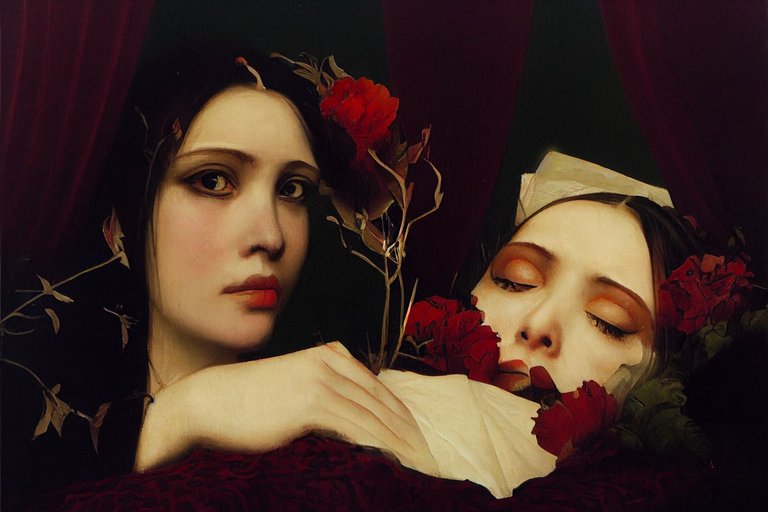
The final result - A Woman Mourning herself.
How I got there
Among my favourite paintings is The Young Martyr by Paul Delaroche. He, of course, famously pronounced "From this day forth, painting is dead", upon his understandings of Photography. The man could not have been more incorrect. His work bordered on the photographic, he was a master of light, and perfectly wove narrative and symbolism into his work.
As a result, he is a prime inspiration for me in my ordinary photographic practice, and now, here, for a collobaration between myself, MidJourney, and the trained data points of Paul Delaroche's deep, dark, moody painting style.
I started with a prompt from a poem I'd written previously, and yielded some interesting results.
she never seems to smile When she's falling apart The word is so sad To her broken heart a painting in the style of paul delaroche

I preferred the third variation due it its composition. The rule of thirds is observed, and her eyes look back toward the negative space in the frame, as though she is regretful, or sad, as the prompt suggested.
Enlarging this, the details are rather rough and the pain in her eyes isn't captured as exquisitely as my eye tends to infer more detail in the smaller version.
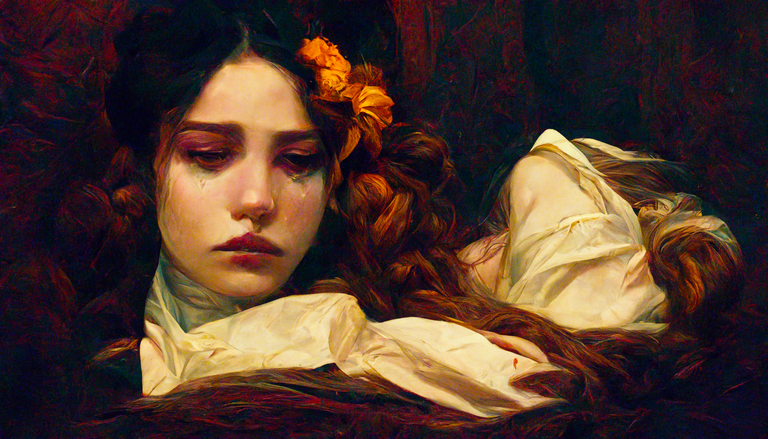
This is clearly painted in broad strokes, not at all in the style of Delaroche, but there is an enhance button available, so why don't we have a go and see what the notions of this in greater detail may evoke?
To my suprise, I am immediately confronted with what could be percieved as a funerary scene.
It is as though she mourns herself in this image, changing fundamentally the narrative of my prompt, and enriching the creative process, allowing me to accept some other branches beyond my prompt.
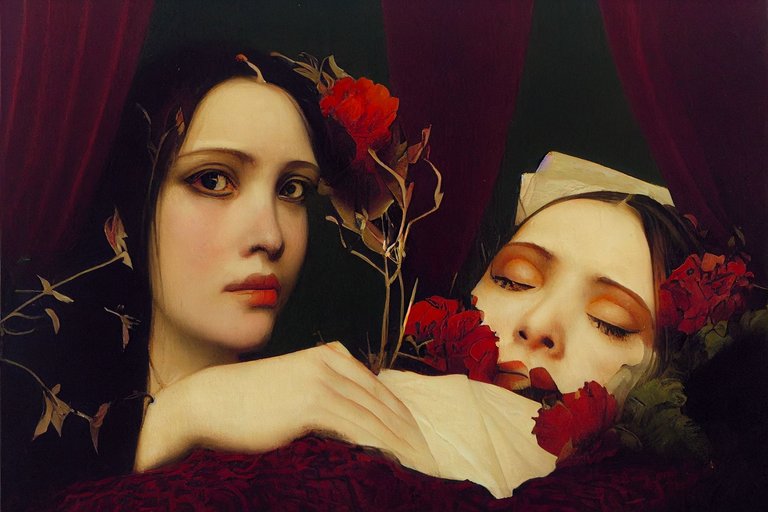
Notions of "Falling apart" must be inferred by way of recognising that we're looking at the same individual mourning themselves. After a few attempts to push the existing concept towards something more impactful, the "machine" inspires me to try to get something more literal produced in the line of someone mourning themselves over their own casket, painted in this same style.
a woman mourning over a coffin in a dark room :: she mourns herself :: she never seems to smile the world is so sad a painting in the style of paul delaroche
I forgot to set the correct aspect ratio, so I got some square images instead of the landscape canvas I wanted.
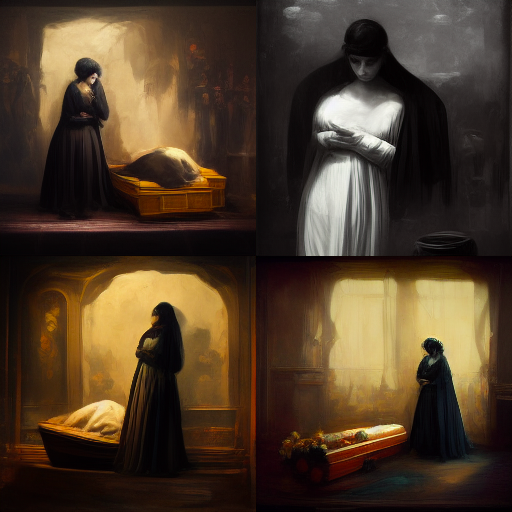
Certainly, we got a mourning woman, but she is not mourning "herself", she is mourning "by herself", so I will likely need to refine the prompt further. First, let me see and make an assessment on what the wide screen aspect ratio outcome came to be:
Again, image #3 is the most impactful, but she is not quite mourning herself.
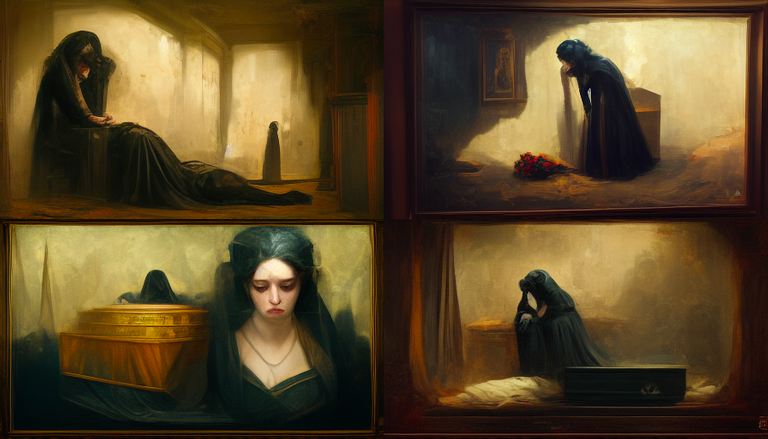
That expression is one of the most haunting I've seen Mid Journey create at this point. The vagueness and shadowy moods of the other compositions are really well produced, and do incredible things to set the mood of loss.
I want the loss of the self to be the pronounced and key concept. I want this to be literal and visceral.
I want to modify the prompt slightly.
a woman looks into an open coffin in a dark room inside the coffin she sees herself she looks sad a painting in the style of paul delaroche
The frames as a a result of three and four are interesting, but the first variation is likely the closest to what I have envisaged. It is not quite there yet. I will run a few more iterations and remember the correct aspect ratio as I iterate upon this concept and tweak the idea further.
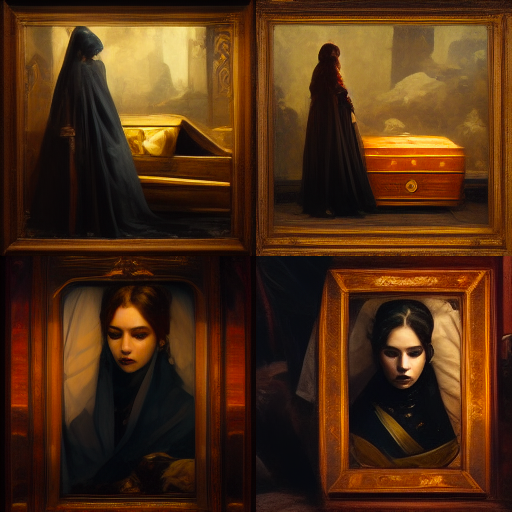
a woman looks into an open coffin in a dark room :: inside the coffin she sees herself :: she looks sad :: she never seems to smile When she's falling apart :: a painting in the style of paul delaroche
Adding the two :: ensures the Ai understands context a little better. I again forgot to set the correct aspect ratio in my eagerness to iterate upon the developing work.
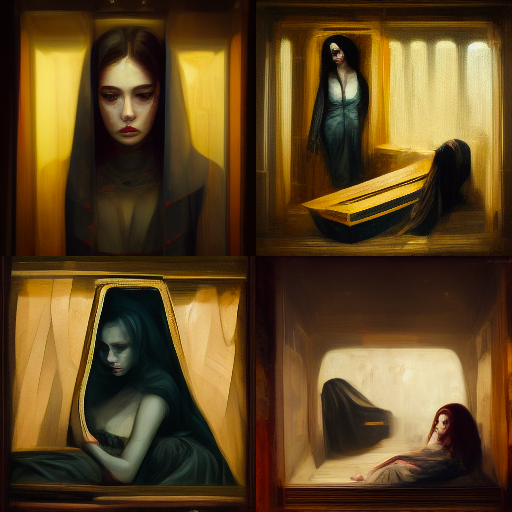
Its a good thing I got the wrong aspect ratio, because none of these work to convey the topic I am trying to convey in a single image quite literally. These are very abstract representations of the prompt, with #2 perhaps being the closets, though we've lost the open casket, and we definitely don't have two figures.
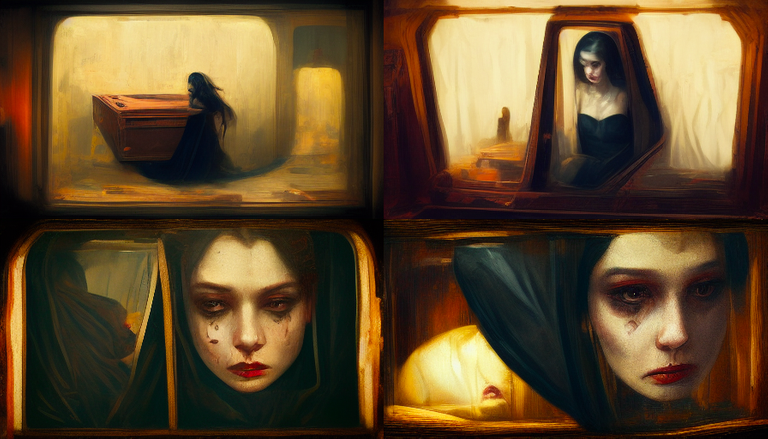
How elaborate and dramatic is frame 3? It would make for an excellent character design, but it does not meet the criteria of what I am trying to convey. Four could've, with a casket open in the background; but we're missing that detail. The cosmetics are a bit heavy; and not suitable for the mood I'm going for, so I tweaked the prompt once more.
a woman observing her twin in an open coffin in a dark room :: two women :: she never seems to smile when she's falling apart :: a painting in the style of paul delaroche --ar 16:9
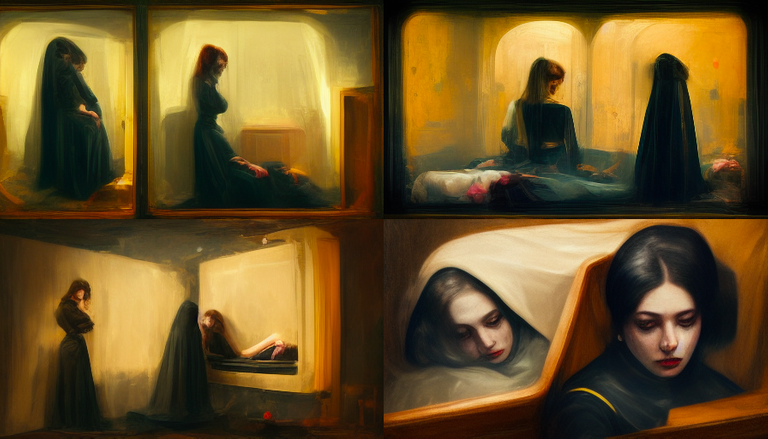
This is becoming closer to correctly representing my new concept, but I think I need a few more iterations. I like a combination between #2 and #3; both are strong compositionally, while #4 comes very, very close to conveying the entire mood I'm after, but I've never known anyone to lie in a casket on their belly.
Let's try for another iteration. The following examples are also not what I want. I will try one more time before I tweak the prompt further.
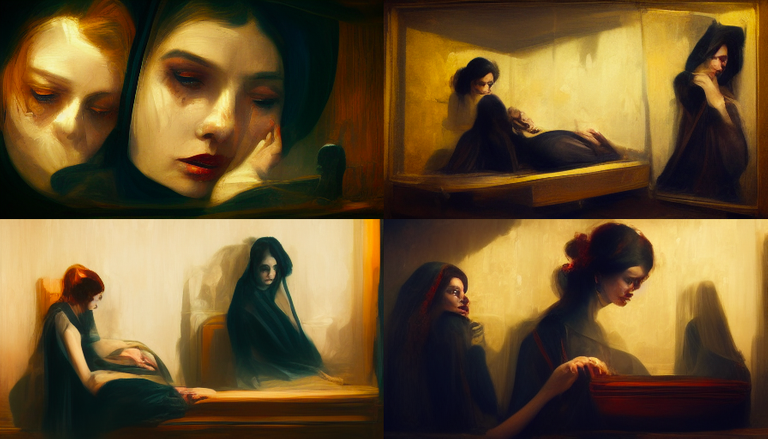

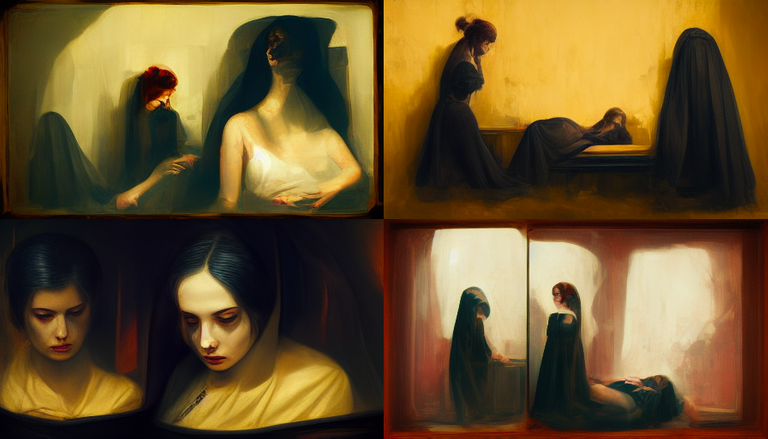
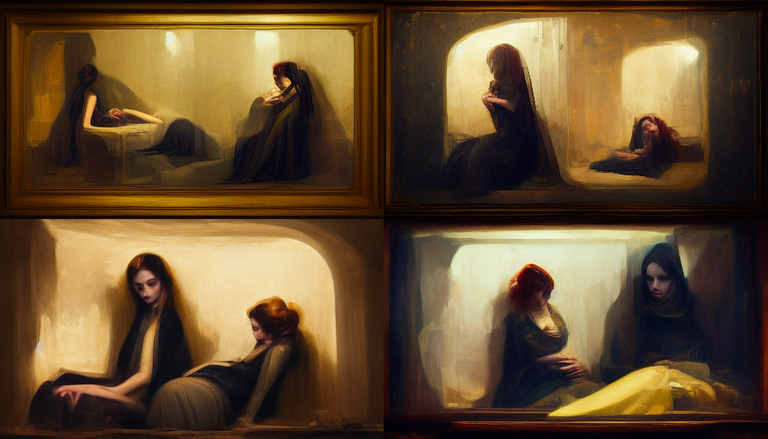
So many iterations, none quite landing where I want them to. In the final composition, #1 shows promise but they're all strangely evocative.
I can't tell if they are evocative because I waited with bated breath for each iteration to complete, or because I am now imposing meaning upon these images through repeated attempts to achieve my desired outcome.
a twin sister observing her sister in an open casket at a wake :: she never seems to smile when she's falling apart :: a painting in the style of paul delaroche --ar 16:9

Closer. Much closer. These are very much almost pictorial enough for me to get the message and vision across.
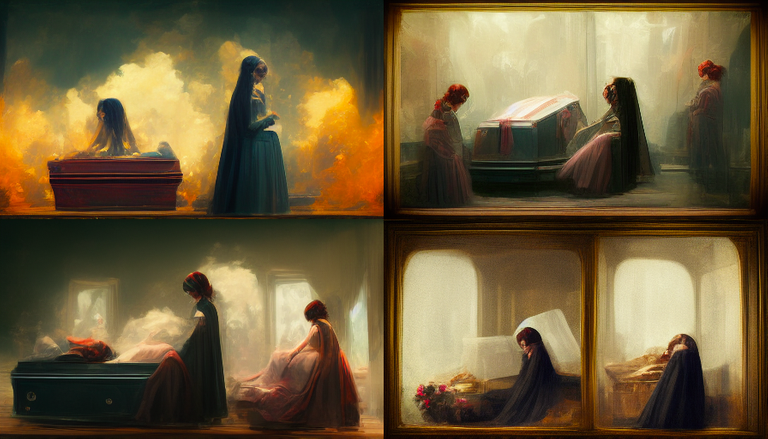
I thought I could perhaps modify the first image in this iteration to be a mirror image, enabling the woman to be looking into the coffin for a better composition, but, this was not the case, it did not flow with any of the common rules of composition, so I attempted further iterations.
I'm so close to what I want now, I think with a few more tweaks of the prompt, I might be able to get there.
an open coffin containing a woman. she is being mourned by another woman, her twin, a painting by paul delaroche --ar 16:9
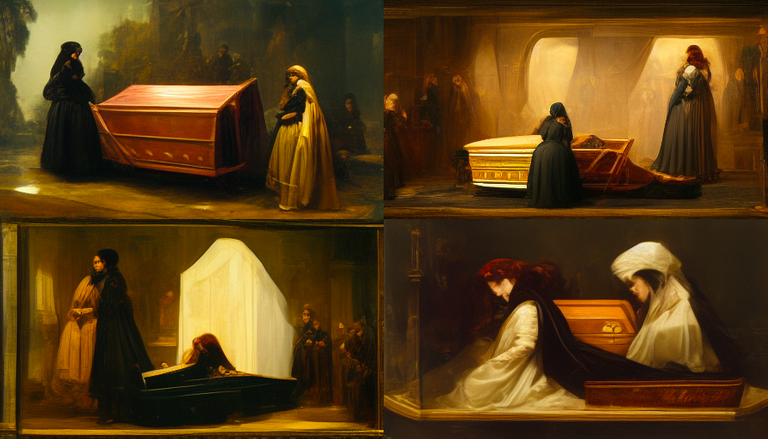
Not quite. It is at this point that I want to create variations of the original image that cast me down this path, while simultaneously exploring this new prompt, with additional tweaks along the way.

These are really excellent images exploring the underlying theme, but they are not quite getting to where I want them to be.
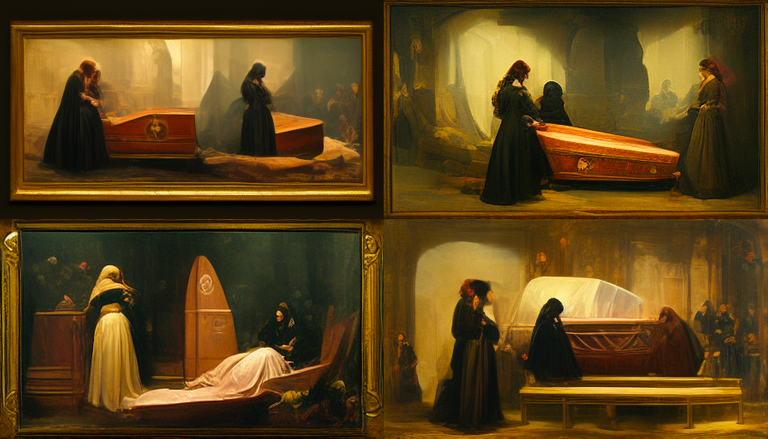
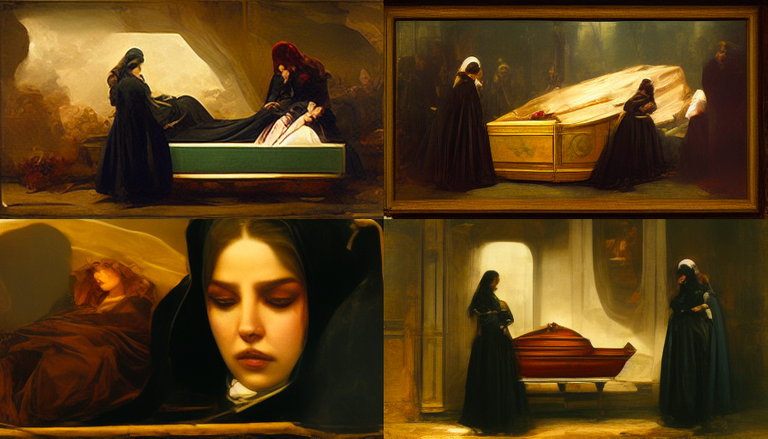
Here, number three makes me want to change the prompt ever so slightly to give the bot more hints about the result that I want to see.
woman mourning at an open casket of another woman. woman in casket is clearly visible she never seems to smile a painting by paul delaroche --ar 16:9
a sprit hovering above an open casket at a funeral wake while a mourning woman looks at the casket a painting by paul delaroche --ar 16:9
a woman mourns herself at her own funeral open casket, open coffin, sadness, clear details, two women sad a painting by paul delaroche --ar 16:9
It is at this point that I want to abandon all these other prompts and angles and settle upon the first image, with my meaning imposed upon it, but I'll try a few more variations first...
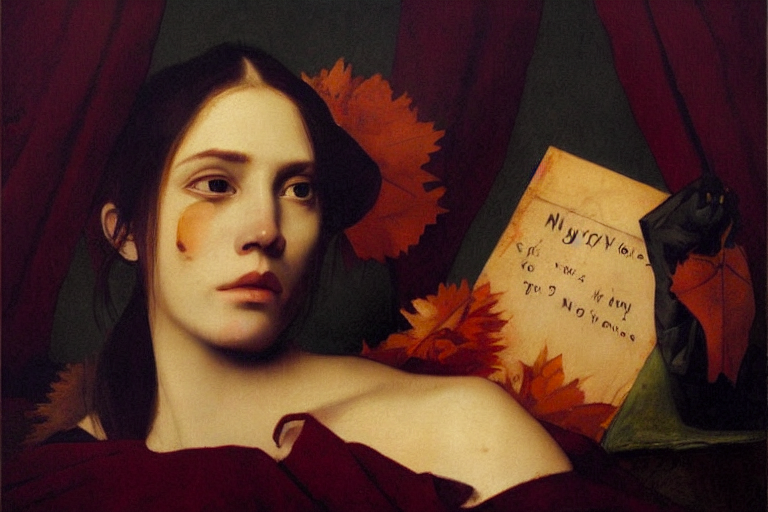

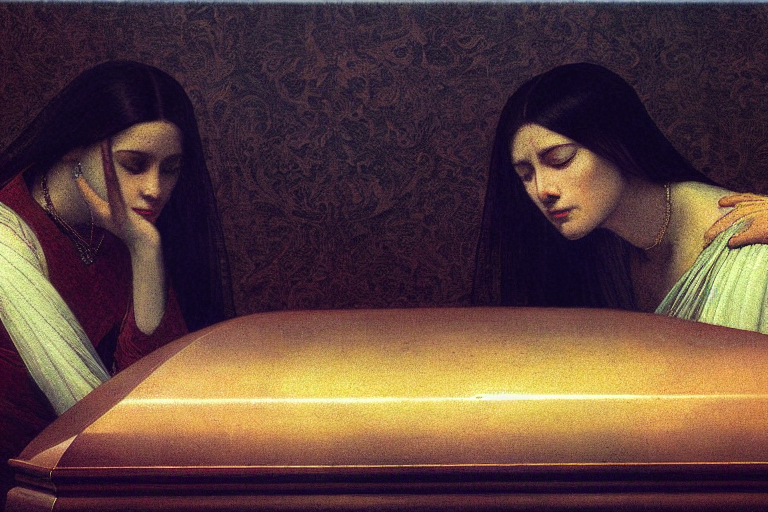
Back to the first image, and into Photoshop to make some changes...
I completed some liquify enhancements to make the characters appear a little bit more human, and then followed this up with some slight lighting tweaks.

I freaking loved everything about your post. My goodness, you know what's freaking amazing?
From the start, from the first 4 branches imagery created, I would have chosen a totally different one (U4), the fourth one because I feel that there's a certain warmth in her and that's what I was drawn to.
Anyway it just shows where the creative control reside, YOU are in charge of your process, and that's just so damn cool to watch & read.
PS: On a side note, I've noticed something about "—ar 16:9"
Instead of putting --ar 16:9
Put —ar 16:9
They look similar, but the latter is a special character called "Em dash" that isn't always on every keyboard. It represents a "," in coding sometimes apparently.
Don't worry I also mistook it for double "-" at first.
I don't know if it has an incidence, but you never know in "coding".
Thank you! I plan to put together many more posts just like this as creation is an addiction for me. 😄
Looking back at the fourth one, she is wonderfully melancholic, in the vein of Edgar Allan Poe "nothing more beautiful that a dying woman" (or whatever the phrase was) - but yes, this is the important thing about AI Art. There's (for now) a human curating and guiding the act.
Coupled with "touch ups" and further manipulations down the line, the work is truly something created using a tool instead of just "type the thing and get the thing".
It is the same process as making any other form of Art for me, experimentation, iteration, and review.
I'm learning Python at the moment as well, so definitely understand those little bits of data that are different depending on the character encoding and other bits and pieces, this is not something that I've noticed ever before.
I just have a standard keyboard and there seems to be no Em Dash key :D
THere's actually a way to create it with holding down the Alt key and type 0151 on your num pad!
I remember playing with that sort of stuff in high school :D
Alright I am back!
It apparently doesn't matter if it's -- or the other one! All good
You can also use ::